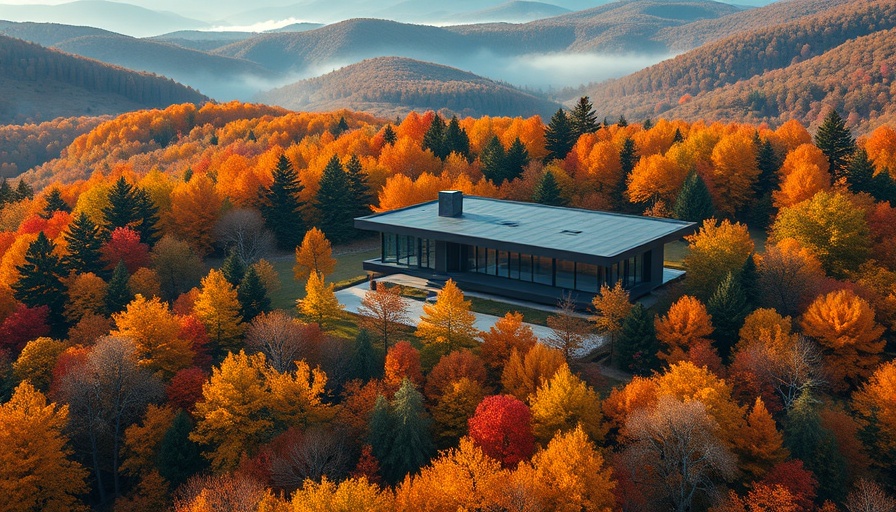
Transforming a Home into a Gallery: Price Harrison's Vision
In the heart of Nashville’s Green Hills neighborhood, architect Price Harrison has redefined the concept of living and art with his stunning Green Hills Residence. Intended to function as both a personal home and an art gallery, this stucco-clad masterpiece is tailor-made for the couple's collection of photography and minimalist art. Boasting an open-air courtyard, the residence prioritizes the display of art, allowing the collection to take precedence within its thoughtfully designed spaces.
The Art Gallery Home Concept
Harrison’s architectural philosophy was to create a residence that acts as an art gallery, where both living spaces and art coexist harmoniously. The L-shaped design of the 3,400 square-foot home emphasizes an integration of aesthetics and utility. Much like the Inglewood Centre for Contemporary Art transformed a personal space into a cultural hotspot in Nashville, Harrison’s home is an embodiment of how domestic environments can concurrently serve as artistic platforms.
A Natural Integration with Surroundings
Set on a sloped, one-acre lot framed by lush woodlands, the Green Hills Residence is not only aesthetically pleasing but also ecologically attuned. Inspired by organic landscapes, the architect chose dark anthracite stucco that mimics the texture of tree bark, allowing the house to blend seamlessly into its natural surroundings. This relationship with nature enhances the indoor-outdoor flow, making artwork feel as though it continues outdoors, much like the audience-engaging projects seen at the Inglewood Centre, where art meets the environment.
The Layout: Function Meets Aesthetic
With the primary living areas located on the ground floor, guest accommodations situated on the upper level, and a central courtyard visible through extensive glazing, the layout strikes an ideal balance between functionality and sophistication. Public and private spaces are cleverly integrated, echoing the curatorial precision exercised by curators in contemporary art spaces. For digital nomads working from home, this design acts as a reminder that a workspace can be both functional and enriched by artistic stimulus.
Thoughtful Interior Design for Art Enthusiasts
Inside, the house is adorned with a curated palette of black and silvery grays, selected with the artistic vision in mind. Interior designer Marilyn McMackin played a pivotal role in creating a cohesive setting that not only compliments the Harrisons' art collection but enhances the overall aesthetic experience. The monochromatic color scheme emphasizes the vibrancy of their artworks, a crucial element for anyone looking to create an inspiring workspace at home, especially for remote workers.
Practical Insights for Remote Workers
For digital nomads looking to harmonize work and creativity at home, Harrison’s residence offers a model to follow. Consider investing in multifunctional spaces that allow for both work and leisure, integrating your personal interests into your home decor. Additionally, choosing a color palette that complements the art in your space can significantly enhance your mood and productivity, an important factor to consider when designing efficient remote workspaces.
The Future of Home and Art
The design of homes like Harrison's may signify a broader trend toward personalizing living spaces to reflect individual artistic values. As seen in both the Green Hills Residence and the Inglewood Centre, blending art with daily life is not just an aesthetic choice; it represents a lifestyle that cherishes creativity in every aspect of existence. For remote workers, this could mean establishing a dedicated workspace that also showcases personal art collections, transforming everyday routines into inspiring experiences.
As we observe this ongoing fusion of art and living spaces, the potential for homes to evolve into dynamic galleries encourages us to reimagine our environments. For those looking to create their own sanctuary filled with inspiration, take cues from these models where art is not just viewed but lived with.
Your Next Steps to Create an Artistic Workspace
If you are feeling motivated to reimagine your own workspace, consider how you can incorporate elements of design that promote not only productivity but also personal expression. Whether it’s through curated art, modifications to your layout, or color selections, transforming your space can greatly affect how you work and live. Start small by choosing a few pieces of art that resonate with you, or consider the arrangement and organization of your workspace to create a fluid transition into your artistic pursuits.
By embracing these ideas, you can craft a beautiful balance between functionality and creativity in your home—much like Price Harrison has achieved in his Nashville residence.
 Add Row
Add Row  Add
Add 




Write A Comment